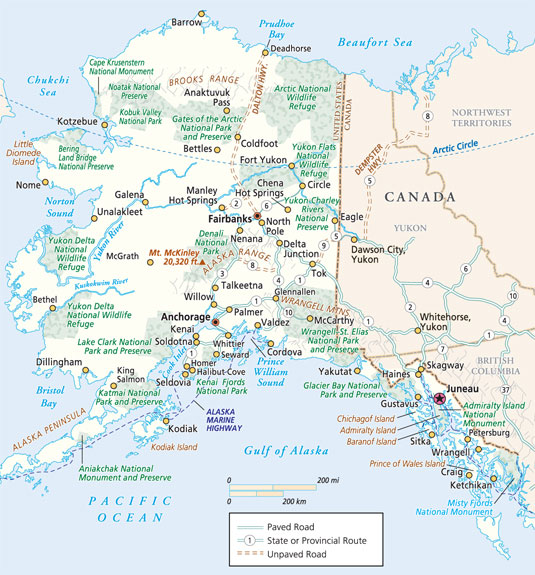Alaska is the largest state in the country, more than twice the size of Texas, so traveling between destinations requires some planning. If you’re deciding your route based on the animals you hope to spot, the following Alaska wildlife chart shows you where to go. Use the transportation chart and mileage chart to plan how to get there and how far you’ll have to travel.
>
>
Making Your Way around Alaska
To get from town to town in Alaska, you’ll likely need more than just a rental car. Some communities in Alaska are isolated enough that you can get to them only by plane or by boat. This table shows which mode of transportation you need to get to particular Alaskan towns.
| City | Air | Ferry | Rail | Road |
|---|---|---|---|---|
| Anchorage | Jet | X | X | |
| Barrow | Jet | |||
| Denali National Park | X | X | ||
| Girdwood | X | |||
| Homer | Prop | X | X | |
| Juneau | Jet | X | ||
| Katmai National Park | Prop | |||
| Kenai | Prop | X | ||
| Kodiak Island | Jet | X | ||
| Mat-Su | X | |||
| Nome | Jet | |||
| Seward (Kenai Fjords National Park) | X | X | X | |
| Sitka | Jet | X | ||
| Skagway | Prop | X | X | |
| Whittier | X | X | X |

>
>
>
Alaska Mileage Chart
How far are you from the next destination on your Alaskan itinerary? This chart shows you the precise distances from different locations in Alaska, so you don’t have to bring a ruler and calculator along with your map.
| Anchorage | Fairbanks | Homer | Kenai | Seward | Skagway | |
|---|---|---|---|---|---|---|
| Anchorage | 358 | 226 | 157 | 126 | 832 | |
| Fairbanks | 358 | 584 | 513 | 484 | 710 | |
| Homer | 226 | 584 | 83 | 173 | 1,058 | |
| Kenai | 157 | 513 | 83 | 105 | 967 | |
| Seward | 126 | 484 | 173 | 105 | 958 | |
| Skagway | 832 | 710 | 1,058 | 967 | 958 |
>
>
>
Spotting Alaska’s Wildlife
Ask visitors to Alaska, “How was your trip?” and they usually respond by telling you what kind of animals they saw, such as “We saw two bears and a whale.” This rule holds true even for lifelong residents who’ve been traveling in the state. This chart gives you a quick rundown of the potential wildlife highlights of your travels.
| What It Is | What to Look For | Where to Find It |
|---|---|---|
| Bald eagle | 6- to 7-1/2-foot wing span; a distinctive white head. Younger birds have mottled brown plumage. | Common in coastal towns of Southeast and Southcentral Alaska, such as Seward, Homer, Juneau, and Sitka. |
| Black bear | 5 feet long and not necessarily black; smoother back, have bigger ears, and longer, straighter nose than brown bears. | Locals in coastal communities often know salmon-spawning streams where bears congregate. |
| Brown bear (grizzly bear) | Up to 9 feet tall when standing; humped back; smaller ears than black bears. | Denali National Park; Katmai National Park; Kodiak Island; Admiralty Island near Juneau. |
| Caribou | 4-1/2 to 8 feet long; like open country; travel in groups. | On broad, wide-open tundra (for example, along northern Interior highways); Denali National Park; the Arctic. |
| Dall sheep | 4 to 5 feet long; curled horns; less shaggy than mountain goats. | High, craggy mountains; on the cliffs along the Seward Highway near Anchorage. |
| Humpback whales | 50 feet in length; white fins up to 14 feet long, which they use to slap the water. | Icy Strait near Gustavus, accessible by tour boat from Juneau or as part of a trip to Glacier Bay National Park; Sitka Sound near Sitka; Resurrection Bay and Kenai Fjords National Park near Seward; Prince William Sound near Whittier. |
| Moose | 7 to 10 feet long and up to 7 feet high; brown, shaggy hides; bulbous noses; heavy antlers. | Much of Alaska; most reliably in Interior and Southcentral regions, especially along a road in wet, brushy country. |
| Musk ox | 4 to 5 feet high; big, shabby mop; curved horns. | Tundra roads from Nome. |
| Orca whale (killer whale) | 23 to 27 feet in length; tall, black dorsal fin. | Resurrection Bay from Seward; Prince William Sound from Whittier; waters near Juneau. |
| Polar bear | 8 to 10 feet long. They’re unmistakable. | Point Barrow, on the Arctic Ocean shore, north of Barrow. |
| Puffin | 14 inches tall. Horned puffins are the most familiar and have tufts of feathers curling back from their heads. | Kenai Fjords National Park; Homer; Sitka. |
| Sea otter | Up to 4 feet in length. They’re distinguished from seals and sea lions by their legs (rather than flippers) and by their swimming posture (more above the water’s surface). | All coastal waters off rocky shores; most common in Prince William Sound and near Sitka, Juneau, Seward, Homer, Kodiak. |
| Wolf | 3-1/2 to 6-1/2 feet in length. Listen for the howl during quiet outings in the evenings. | Denali National Park and other mountain tundra areas with long views, such as along the Richardson or Denali highways. |
>
>
dummies
Source:http://www.dummies.com/how-to/content/alaska-for-dummies-cheat-sheet.html
No comments:
Post a Comment